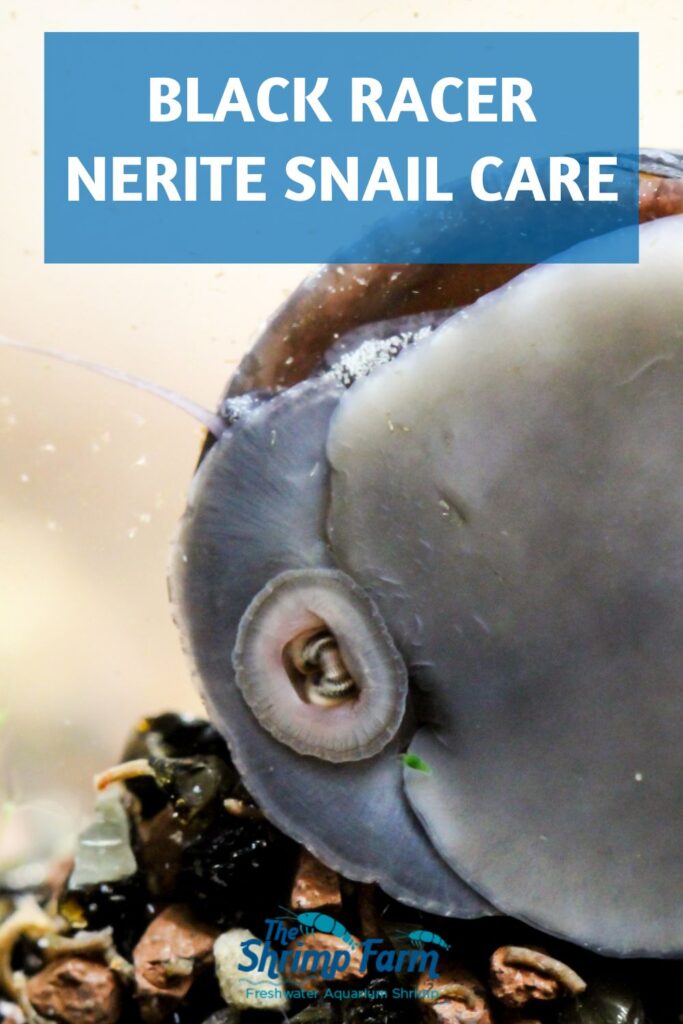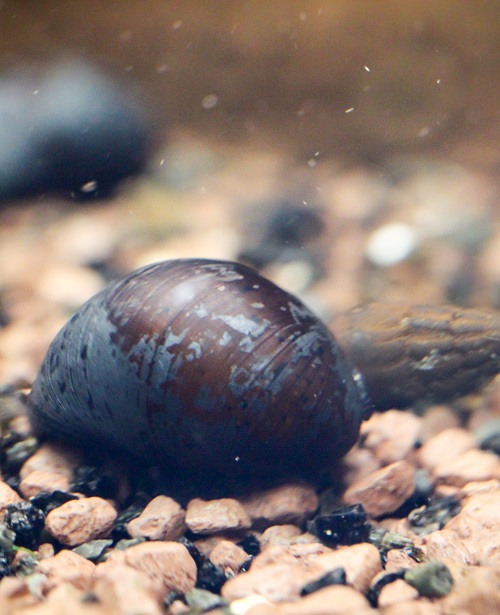Black racer nerite snail | Neritina pulligera care & info
In search of a peaceful, algae-eating addition to your shrimp aquarium? Look no further! The black racer nerite snail (Neritina pulligera), also known as the dusky nerite or black military helmet snail, may be just what you need.
Let's go into black racer nerite snail care and how to make sure this beautiful snail species thrives in your aquarium!
| Scientific name | Neritina pulligera |
| Common name | Black racer nerite snail, black military helmet snail, black-capped nerite, dusky nerite |
| Difficulty level | Easy |
| Origin | Indo-Pacific regions |
Table of Contents
Black racer nerite snail natural habitat & appearance
Neritina pulligera is a small snail that grows to a maximum size of around 1". Naturally found in a wide range of habitats throughout the Indo-Pacific, it occurs in parts of Australia, South East Asia, Japan, various islands in the Indian and Pacific Oceans, India and southeastern coastal Africa.
It's considered a species of Least Concern by the IUCN Red List and prefers fast-flowing streams and rivers with a rocky substrate. Because these habitats are usually coastal and affected by the ocean tides, this is one of the many nerite snails that does well in both fresh and brackish water.
Unlike some other nerite snails, which can be exquisitely colorful, black racers are fully dark brownish-grey in color. They're still a pretty decorative species to see, though, with a shiny shell that barely shows any of the foot (body). Only the antennae stick up as they zoom around the tank in search of algae.
Black racer nerite snail aquarium
This nerite will do well in most aquariums with a water volume of 5 gallons or up. In larger tanks, you could consider going for one nerite per 10 gallons.
They aren't fussy as to décor at all, although they probably appreciate some rocky surfaces to forage on. Live plants are also a plus.
Water quality
If you'd like to keep black racer nerite snails in your aquarium, make sure the tank is fully cycled before introducing the snails. Traces of ammonia and nitrites can quickly prove fatal, as do copper-based medications and aquarium plant fertilizers, so be sure to absolutely avoid those. Nitrates should be kept low by means of weekly small water changes.
Although black racers aren't too fussy in terms of water parameters, it's important to remember that they don't always do well in more acidic waters. The lower pH can affect their shell, causing it to deteriorate and fail to grow properly. Calcium supplements can help, but we would still advise against keeping these snails in tanks with a pH under 7.0. They like an alkaline environment with relatively hard water for healthy shell production.
pH: 7.0-8.0
Temperature: 71.5-82.5 °F
GH: 6-8
KH: 4-8
Tankmates
The nice thing about aquarium snails like these is that they're entirely peaceful. This is exactly why they're so popular among (dwarf) shrimp keepers, as they're among the only tankmate options for their fragile shrimp. You can combine them with any shrimp that doesn't require more acidic or soft water.
This being said, black racer nerites are also perfect for other types of peaceful community aquariums. Although their protective shell makes them quite sturdy, it's best to avoid aggressive, snail-eating or nippy tankmates like larger crayfish species, loaches and the like.
Black racer nerite snail diet
Aside from their decorative looks and peaceful disposition, it's their diet that really makes nerite snails so beloved in the aquarium hobby! Like many of the other members of its genus, the black racer nerite snail mainly feeds on algae. It's a highly effective and active algae eater that will spend the majority of its day zooming along the tank looking for green patches to mow. They like all sorts of soft algae, including green film algae and brown diatoms.
Because nerite snails are so effective at cleaning their environment of green and brown film, you'll have to supplement their diet to avoid yours from going hungry. They're not fussy about food: a high-quality shrimp food is perfect since it's designed for herbivores. Algae tabs and blanched veggies will also be appreciated.
Although you may see your black racers crawling on your aquarium plants, you won't have to worry about your greenery falling prey to hungry snail mouths. They're just scraping off algae and biofilm. Plants are left alone unless they're already decaying.
Breeding black racer nerite snail
Like other nerites, black racer snails don't reproduce in freshwater. They need a brackish environment for their eggs to hatch. A big advantage if you're worried about pest snails taking over your tank!
The downside is that although they can't hatch, your black racers will still lay eggs. These white specks can be unsightly and difficult to remove, although a razor blade should usually do the trick if they're on the tank glass. Some sources also report that horned nerites eat other nerite snails' eggs, although we haven't personally tried this.
Frequently asked questions
No, they don't. Nerite snails will only eat dead or decaying plant matter, not live plants.
In a 10-gallon aquarium, you can go for 2-3 nerite snails.
It varies, but they technically have the capacity to produce eggs every few days!
Buying black racer nerite snail
Black racer nerite snails are still a relatively new addition to the aquarium hobby, but some aquarium stores may carry them or be able to order a few in for you. You can also buy them online.



 Shrimp
Shrimp Fish
Fish Crab &
Crab & Plants
Plants Foods
Foods Snails
Snails

